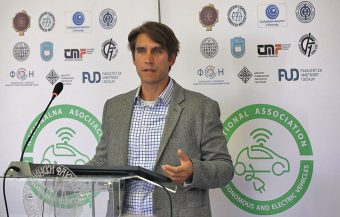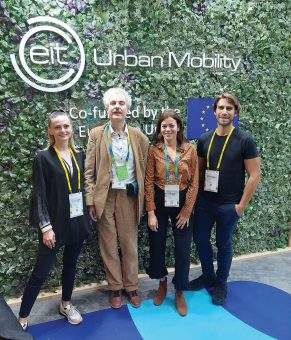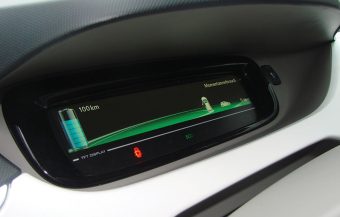
In cooperation with the Faculty of Mechanical, Traffic and Electrical Engineering, the National Association of Autonomous and Electric Vehicles (NAAEV) is holding the sixth E-mobility Forum in Belgrade on October 11 and 12. The Forum will be organized under the auspices of the Ministry of Science, Education and Technological Development and the Ministry of Construction, Transport, and Infrastructure. The event will focus on challenges and innovative technological solutions in autonomous and urban mobility, including industry, academia, and city representatives. We spoke with Dalibor Ignjatović, Director of Innovation at NAAEV, about how far Serbia is on the road to the development of e-mobility and what measures should be implemented for people to travel safer and faster with electric vehicles.
“We started in 2015 with the idea of incorporating Serbia into the changes underway in global mobility at that time. We aim to direct Serbian scientific research and industrial potential towards cooperation on projects focused on innovative urban mobility solutions. Thanks to a contract, we have included the 11 largest technical faculties in Serbia and 14 domestic high-tech companies. In 2019, NAAEV received the status of HUB for Serbia from the European Institute of Innovation and Technology—Urban Mobility (EIT-UM), and this year we became a member of the European Association Connected, Cooperative and Automated Mobility (CCAM). As a result of the engagement of its capacities within a significant number of European urban mobility projects, NAAEV has become a contact point for scientific and research institutions, companies, and cities in Serbia, which the Association directs and includes in projects related to development, research and testing of electric and autonomous vehicles, infrastructure, and their components”.
IN FOCUS:
- ENERGY REHABILITATION CONTRIBUTES TO ENERGY SAVING AND ENVIRONMENTAL PROTECTION
- THE TREND OF GROWING ELECTRIC CAR SALES
- HOW TO DEVELOP ELECTROMOBILITY IN SERBIA FASTER?
How have the authorities responded to NAAEV’s activities on engaging scientific and research potential in the development of electric vehicles?

Bearing in mind the scope and dynamics of changes in electric and autonomous transport, NAAEV forwarded several strategic initiatives to the Serbian government and line ministries regarding developing this field in our country. These include the 10-point Studies Programme for Electromobility in Serbia and the Guidelines for the Development of Electromobility in Serbia from 2019 to 2025, which contains 10 measures, the implementation of which puts Serbia on an efficient path towards e-mobility. We proposed the formation of an interdepartmental working group and the deadlines within which these measures could be implemented. However, so far and despite the steps towards the improvement of e-mobility that are being undertaken in Serbia, a lot of things are done slowly and are unsynchronized, because a clear institutional infrastructure has not been established yet, nor the necessary regulatory and strategic environment.
According to your estimates, how many electric four-wheelers are there in Serbia and how many chargers? How do you evaluate infrastructure development, and how can e-mobility develop faster?
This question is seemingly easy to answer. According to certain criteria, plug-in hybrid electric vehicles and hybrid vehicles can be counted as e-vehicles. These two categories, as well as Battery Electric Vehicles, significantly contribute to green transport implementation.
As part of the study on the development of electromobility for the city of Belgrade from 2022 to 2030, which was carried out by NAAEV and commissioned by the World Bank, an assessment was made according to which, by the end of 2022, almost 11,500 e-vehicles in Serbia that belong to the aforementioned vehicles should have been registered, which is less than one per cent of the total number of vehicles in the country. The study also showed that over 90 per cent should have been plug-in hybrid vehicles. The key point of the transition towards the electrification of private and public transport vehicles is the establishment of an adequate e-infrastructure, i.e. the availability of charging stations. In addition to undefined regulatory aspects in Serbia, the limited number of charging stations for electric vehicles is one of the main obstacles to carrying out the electric transition easily and quickly.

According to your estimates, at what rate will the number of e-vehicles and chargers increase in Serbia in the coming period? How can we improve the charger network?
Bearing in mind the analysis that the World Bank commissioned, the assumption is that the growth of the number of battery-powered electric vehicles and hybrid electric vehicles in Serbia on an annual basis in the period until 2030 will amount to five per cent. As for chargers, according to the same analysis, Serbia will need slightly more than 2,000 EV charging stations by 2030 to fulfil the needs of the expected number of users. I would like to underline that this is not only about the number of required chargers but also their structure and appropriate spatial arrangement. Fast charging (7—22 kW) and Rapid charging (50—99 kW) chargers will be installed in urban areas, while Ultra-rapid charging (100—360 kW) chargers will be installed on motorways.
How are autonomous transport solutions tested in Serbia? Where do we stand when it comes to regulations for autonomous vehicles?
Driverless autonomous vehicles are slowly becoming a reality, and statistics show that human error is the cause of more than 90 per cent of traffic accidents. In some countries, robot taxi services are already functioning and in addition to transporting passengers, robotic delivery in urban areas and, in particular, solving long-distance transportation of goods is a very near future. America and China are leading in developing legislation, which is the primary prerequisite for further developing and applying these technologies. Europe is still far behind in this matter. That’s why the arrival of Self Driving Group, a subsidiary of Yandex, which announced the testing of autonomous vehicles in Belgrade, gives Serbia a significant opportunity to become one of the first European countries to implement these state-ofthe-art services.
Interviewed by: Mirjana Vujadinović Tomevski
Read the story in the new issue of the Energy portal Magazine ELECTROMOBILITY



